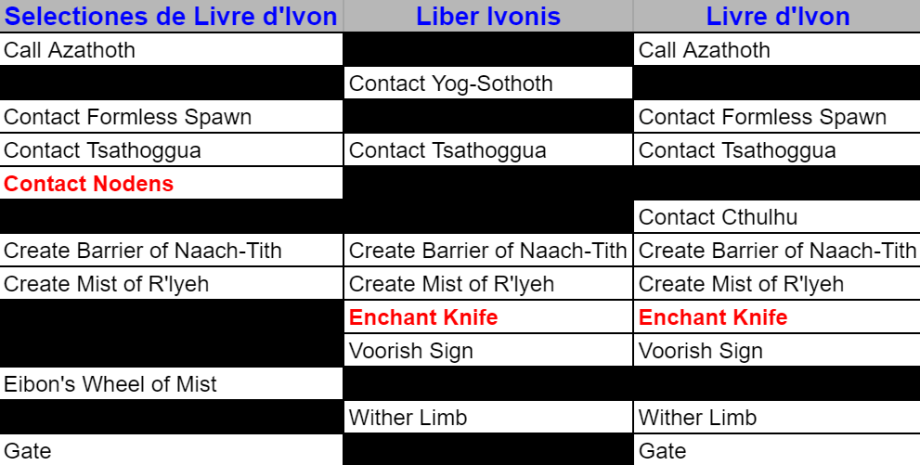If you wish to see some additional background information related to the Book of Eibon, as well as an aggregated presentation of each tome, proceed here.
Location: Shrine to the Bloated Woman (China)
Physical Description: Hand-written manuscript bound in royal blue shagreen (stingray leather)

Author: Attributed to Ivon le Grande, Sorcier de Hyperborée. French translation by Gaspar du Nord from prior Greek manuscript
Publication History: A handwritten French translation of the Book of Eibon by Gaspar du Nord translated from the Greek version of the Book during the 13th century. Du Nord used a version acquired from his former master, Nathaire. Thirteen copies are known to exist, in partial and complete forms, including the Selections mentioned above. Many pages are missing or completely spoiled, which may account for missing spells compared to the earlier Latin translation.
Skim:
Provides details of how the Greek manuscript came into Gaspard du Nord’s hands. The remainder of the text is remarkably similar to the discussion for Libre Ivonis, as below:
Written by the self-described “greatest of all sorcerers”, Eibon, this incredibly dense text contains complex diagrams featuring bizarre geometric shapes, which defy the limited surface of the pages, as well as complex mathematical formulae, extensive discussion of the primal matter of existence and natural philosophy. Much of the knowledge recorded in the book is attributed to a master teacher, “Saccoche”, who is depicted in a grotesque illustration of an obese, drowsing monstrous furry hybrid of a bat and frog. There are additional disturbing and gruesome illustrations of “experiments” and “trials” using a wide variety of vivisected three-toed, fur-bearing humanoids. A notation inside the back cover indicates that the book is property of the Misr House Library. Contains pages of passages in an unknown language (Hyperborean) without translation.
Spells:
Connection to the Broader Campaign:
All three tomes can serve as connections to the Nitocris portion of the campaign. If you wish to link your campaign to the Shadows of Yog-Sothoth, Carl Stanford may be interested in this version of the text due to the Contact Cthulhu spell.
Thorough Reading:
General Content:
A full study elaborates on the story of Eibon the Great, who lived in a five-story, five-sided tower constructed of black gneiss along the towering cliffs fringing the sea in Mhu Thulan. This dark stronghold originally served as the laboratory and abode of Xylacus; however, he died mysteriously and the alchemical furnaces grew dark as his cadre of pupils dispersed across Hyperborea. Eibon joined this exodus and studied widely across the land, applying secrets he had learned in his master’s vast study. Eibon employed the proscribed mystical gates to travel between lands and worlds, expanding his knowledge while unsettling his consciousness. Eventually, he returned to Mhu Thulan to reclaim the ebon tower and hone his caliginous craft. In a short time, he became regarded as the most powerful sorcerer in all of Hyperborea. His power only deepened in meeting his new master, Tsathoggua, the Sleeper of N’Kai, in the bowels of Voormithadreth, the extinct, four-coned volcano.
“In that secret cave in the depths of Voormithadreth, lies the somnolent black toad, Tsathoggua, coated in a bat-like fur, his darks orbs gazing through drowsing lids as he surveys his formless spawn flowing like ichorous mercury before his corpulent frame. His ancient mind holds glorious secrets, and I freely offered my service. For that, he has gifted me with precious knowledge and dread artifacts.”
Content Specific to Livre d’Ivon: There is added commentary at the end of this tome revealing the fate of Eibon. The master sorcerer Eibon disappeared shortly after the elk-goddess Yhoundeh’s premier inquisitor and high priest, Morghi, came to his black tower with a writ for his arrest. Under threat from the Inquisition, Eibon fled to Cykranosh (the planet Saturn) through a magic panel gifted to him by Tsathoggua, never to be seen again in Hyperborea. Rumors circulated when Morghi himself vanished close on the heels of Eibon. Many within the Inquisition believed that he was allied with the sorcerer, and their plotting led to a decline in the worship of Yhoundeh. A detailed review of the text includes a spell written in the margins by an unknown hand invoking the Sleeper at R’lyeh, Kthulhut (Contact Cthulhu).
Recommended Reading:
- The Book of Eibon, published by Chaosium
- The Colossus of Ylourgne by Clark Ashton Smith
- The Tsathoggua Cycle, published by Chaosium


